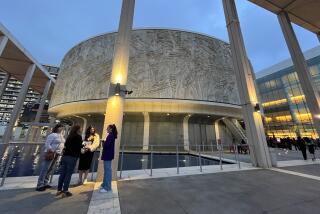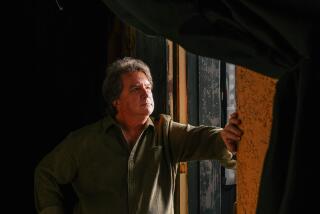[Inside] the Ford helps troupes without homes
For TheSpyAnts Theatre Company, persistence pays. Eight years ago, the small, stage-less ensemble fell in love with a crazy new play called “bobrauschenbergamerica” -- Charles L. Mee’s freewheeling romp through American culture. It requested permission to perform the piece but found the rights were tied up. Undaunted, it kept asking -- and kept getting turned down -- until now.
“Lo and behold, this time the rights were available,” says producing manager Lori Evans Taylor. “Chuck Mee knew this little company in L.A. wanted to do his show and he said yes.”
TheSpyAnts’ tenacity also impressed the Los Angeles County Arts Commission. It chose “bobrauschenbergamerica” for the second season of its [Inside] the Ford New Play Series, which provides troupes that lack permanent homes with a venue and resources to mount productions they otherwise couldn’t afford. Mee’s play -- an L.A. premiere -- opens this weekend at the Ford Theatres in Hollywood.
“We created this series because one of the biggest impediments itinerant companies face is the high cost of renting,” says Laura Zucker, the commission’s executive director. “That often prevents them from focusing on putting money into the product onstage.”
The commission selects three productions for each winter season at the 87-seat [Inside] the Ford theater, which is tucked into a hillside complex best known for its summer amphitheater shows. In exchange for a subsidized weekly rent of $1,000 -- well under the market rate -- groups receive access to the theater and its lighting and sound systems as well as box office, house management, marketing and publicity services. The cozy performance space has its quirks (notably, pesky pillars), but the Ford facility offers amenities such as free parking and ample restrooms.
“Going to the theater is a whole experience,” Zucker says. “What you see on the stage is very important, but everything that happens from the moment you arrive to the moment you leave influences whether you want to return.”
The idea of using practical assistance to promote artistic growth isn’t sexy, but it seems to be effective -- both at enabling small theaters to pursue ambitious work and creating a showcase for that work. The first season began with two world premieres: Moving Arts’ production of EM Lewis’ morality-mortality tale “Song of Extinction” (which won the 2009 Harold and Mimi Steinberg/American Theatre Critics Assn. New Play Award) and Circle X Theatre Company’s production of Jim Leonard’s “Battle Hymn.” This season’s opener, Ensemble Studio Theatre- Los Angeles’ staging of Julie Hébert’s “Tree,” debuted to strong reviews in November.
“We never would have attempted to produce ‘Battle Hymn’ unless it was at the Ford,” says Tim Wright, artistic director of the 14-year-old Circle X, which is based in Hollywood. “When we started production we had only the first act and a few pages of the second. Normally, we wouldn’t operate that way. But working at the Ford is like working with a net. There’s a lot more opportunity to take risks. We could focus on completing the piece with the writer and the director because we didn’t have to worry about coming up with what ultimately would have been about $30,000 for the rental space alone. We could actually invest in development.”
Last season’s final entry -- “Home Siege Home” -- was a different kind of premiere, Ghost Road Company having worked on its adaptation of Aeschylus’ trilogy, “The Oresteia,” for years. “This was the first time all the pieces were seen together,” says Zucker. “If we didn’t do it, it would not have happened.”
The Ford tries to give a boost to companies as well as productions. With TheSpyAnts, says Zucker, “we went out on a limb because they are not as big or as established as some others. But the play is great and they brought in a great director in Bart DeLorenzo. Hopefully, this will propel them forward.”
Evans Taylor says the Ford has “opened a lot of doors” for her 10-year-old ensemble, offering TheSpyAnts broader exposure and a chance to experiment in areas such as marketing (“we’re running an ad at the Laemmle [movie theaters] on Sunset”). Also, she says, she and her colleagues are working with artists such as DeLorenzo, choreographer Ken Roht and “some wonderful designers who came on board knowing we would be doing the play here.”
The Ford program is “a new model -- one the theater really needs,” says DeLorenzo, founding artistic director of the Evidence Room, a company that has created and lost several homes, including a Beverly Boulevard location that was a hot spot of adventurous theater-going. “This is exciting because in one place you can see several different companies each pouring its resources into a production. Your shot at three good plays is higher than if you had one company trying to do three good plays in a row. I wish there were more examples of this.”
A number of organizations provide or rent venues to specific groups or productions. What distinguishes [Inside] the Ford, says DeLorenzo, “is this is a curated series with quality control.”
Terence McFarland, executive director of L.A. Stage Alliance, predicts more such ventures will start popping up given that, by his estimate, a couple hundred local companies and other groups that put on plays lack homes because they can’t afford them, would rather invest in staff than overhead or fear the demands of running a theater might limit their artistic aspirations.
The Ford’s indoor space has a rich history of nurturing writers and their work. It was created in the 1970s by the Center Theatre Group, which converted part of the 80-year-old amphitheater’s storage area. CTG held the Lab -- which featured readings and workshops -- there first, followed in the ‘80s by the Taper, Too series of new and experimental pieces. When CTG’s lease expired in the ‘90s, the arts commission remodeled the room and gave it its current name. The county joined with A.S.K. Theater Projects and the James Irvine Foundation to host the “Hot Properties” new play series from 2000 to 2004. The Flintridge Foundation helped to support an ensemble theater collective that lasted until 2008.
For [Inside] the Ford, the commission chooses participants through an open competition. (The application deadline for next winter is March 17.) Material that is new or, at least, new to L.A. is preferred. A minimum of three years of producing experience is required.
“We look for a combination of an interesting play and project team with a company that has enough administrative structure to pull it off,” Zucker says. “We want each season to resemble a piece of music in that the tempo keeps changing.”
This season began with “Tree,” an intricate unraveling of race and family relations. “bobrauschenbergamerica,” which runs through Feb. 28, is a collage of vignettes -- love stories, shootings, chicken jokes -- inspired by artist Robert Rauschenberg, the ultimate collagist. In March, Circle X will present the first production of Sheila Callaghan’s “Lascivious Something,” in which an old lover disrupts an American expat’s new life with a new wife on a Greek isle.
Even though the Ford series is young and relatively modest (a $182,000 annual budget), it’s building momentum. Subscriptions have jumped five-fold, from 20 for the first season to 102 for the current one. LA Weekly included the program among high points of the last decade of local theater.
“It sure ignited things for us,” says “Tree” author Hébert. “We not only got a venue -- which allowed us to do the play -- but we got a venue with a great profile that actually appeals to people. And you know how hard it is to get people to come out to see plays in L.A.”
More to Read
The biggest entertainment stories
Get our big stories about Hollywood, film, television, music, arts, culture and more right in your inbox as soon as they publish.
You may occasionally receive promotional content from the Los Angeles Times.






